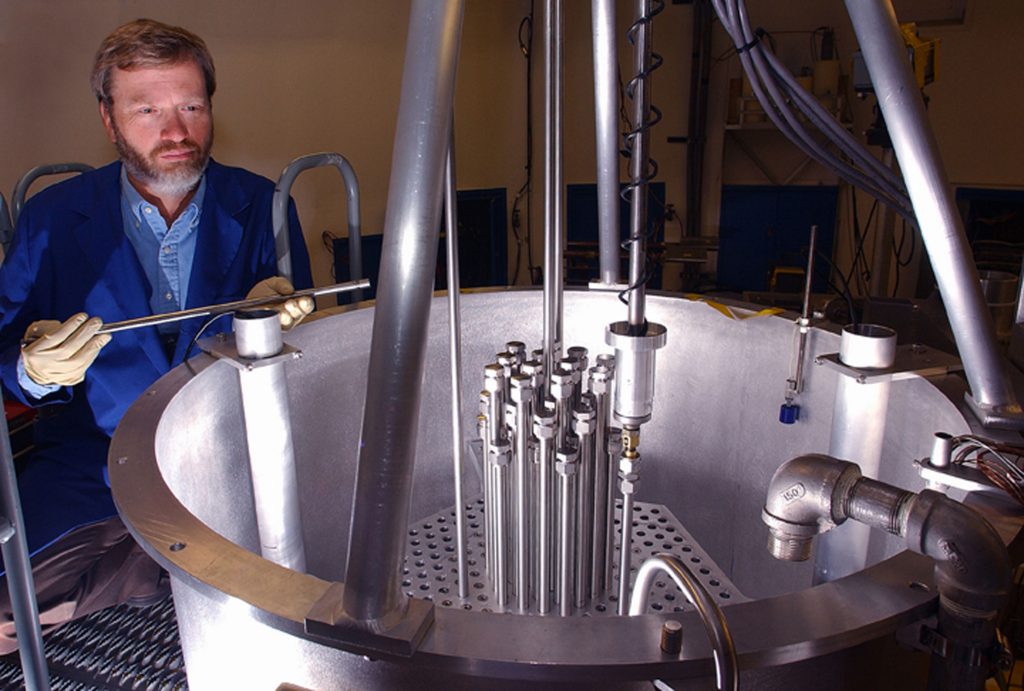ALBUQUERQUE, N.M. — Recent experiments by Sandia National Laboratories researcher Gary Harms and his team are using a new Labs-built reactor to provide benchmarks showing that spent nuclear fuel — uranium that has been used as fuel at a nuclear power plant — is considerably less reactive than the original fresh fuel. This could mean significant savings in the eventual safe transport, storage, and disposal of nuclear waste.


NEW REACTOR: Sandia researcher Gary Harms conducts experiments with a new Sandia-built reactor that are paving the way toward possible changes in regulations on transport and storage of nuclear waste. (Photo by Randy Montoya)
“The conservative view has always been to treat spent fuel like it just came out of the factory with its full reactivity,” Harms, project lead, says. “This results in the numbers of canisters required in the handling of spent nuclear fuel to be conservatively high, driving up shipping and storage costs.”
The more realistic view is that as nuclear fuel is burned, the reactivity of the fuel decreases due to the consumption of some of the uranium and to the accumulation of fission products, the “ash” left from burning the nuclear fuel. Accounting for this reactivity decrease, called burnup credit, would allow for the spent nuclear fuel to be safely packed in more dense arrays for transportation, storage, and disposal than would be possible if the composition changes were ignored.
“Allowing such burnup credit would result in significant cost savings in the handling of spent nuclear fuel,” Harms adds.
This seems obvious on the surface, but in the ultraconservative world of nuclear criticality safety, an effect must be proven before it is accepted. Thus, prior to the Nuclear Regulatory Commission ever agreeing to the more realistic view, it would have to be proven in actual experiments and compared to computer models showing the same effects.
In 1999 Harms obtained a three-year grant from the Department of Energy’s (DOE) Nuclear Energy Research Initiative to make benchmark measurements of the reactivity effects that fission products have on a nuclear reactor. The project was called the Burnup Credit Critical Experiment (BUCCX). Rhodium, an important fission product absorber, was chosen for the first measurements.
To do this the BUCCX team first designed and built a small reactor, technically called a critical assembly, which uses low-enriched fuel. The control system and some of the assembly hardware for the reactor came from the 1980s-era Space Nuclear Thermal Propulsion (SNTP) Critical Experiment project, designed to simulate the behavior of a nuclear rocket reactor.
The reactor, which operated during the experiments at a lower power than a household light bulb, was subjected to several layers of safety reviews. During the experiments, it performed safely exactly as predicted.
“It took us most of the three years to build the reactor and get authorization to use it. Only in the last few months have we begun actual experiments,” Harms says. “Much of the time was involved in getting approvals from Sandia and DOE and to make sure it meets all ES&H concerns.”
The core of the BUCCX consists of a few hundred rods full of pellets of clean uranium that originally came from the nuclear powered ship NS Savannah. Thirty-six of the rods can be opened to insert experiment materials between the fuel pellets. Prior to conducting experiments with the rhodium, the researchers loaded the reactor to critical with only the uranium fuel. This provided a baseline point of where uranium goes critical — information that could be compared to later experiments.
Then, the BUCCX team added about 1,200 circular rhodium foils between the uranium pellets in the 36 rods. The intent was to measure the extent to which the rhodium reduced the reactivity of the uranium.
“We then compared the critical loading of the assembly with the rhodium foils to the critical loading without rhodium,” Harms says.
And, not to anyone’s surprise, it took significantly more fuel to reach critical with the rhodium-doped rods than without them.
Months before running the physical experiments on the reactor, Harms was modeling on Sandia’s sophisticated computers to determine where the uranium doped with rhodium would go critical.
“I was curious,” Harms says, “I did calculations ahead of time so I could lay out the experiment and get a peek at what the experiments would say. In the end, I was fairly impressed with how accurate the calculations were compared to the actual physical experiments.”
Of course, the computer codes weren’t perfect, and had a small bias when compared to other criticality safety benchmarks. And in analyzing the actual experiments in the reactor, Harms took that bias into account.
Harms says two other fission products absorb neutrons better than rhodium. However, he selected rhodium to run the experiments because it is one of the few byproducts of fission that has a single stable isotope, which means the experiment would not be contaminated by the effects of other isotopes. Also, no one else has done any experiments with rhodium in a critical assembly. Subsequent experiments could address the dozen or so other fission products that are important to burnup credit.
Also, to his knowledge, no other lab in the US is doing actual burnup credit experiments. Oak Ridge National Laboratory is running codes to determine how much the reactivity of spent fuel is reduced by fission products, but not doing actual experiments.
At the end of the three-year funding period, Harms says the Sandia program has come a long way in proving that the reactivity of spent fuel is considerably less than that of fresh fuel.
“In essence Sandia is helping pave the way for the Nuclear Regulatory Commission to address the safe and cost-efficient transport and storage of nuclear waste,” Harms says.